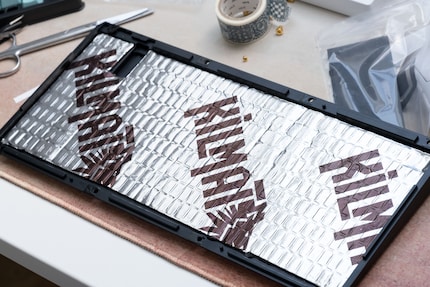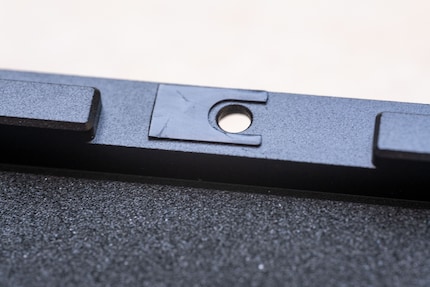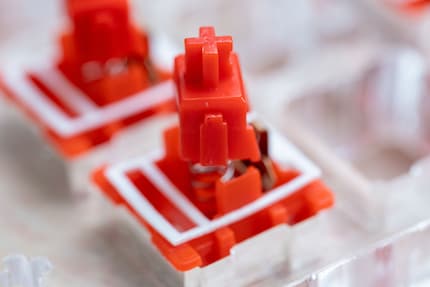
Background information
Having some work done: my new old DIY keyboard
by Kevin Hofer

In my opinion, the Keychron Q1 is the best keyword in our range to date. But it still has room for improvement.
Ping, ping, ping. Every time I type on the Keychron Q1, I get a hollow pinging noise. I first noticed it when writing this review. What causes the sound? The casing. When you type, the aluminum design of the Q1 vibrates. But with three modifications, you’ll be back to tranquil typing.
If I tap my fingers on the bottom of the Q1, I hear it: that unspeakable pinging noise. Unfortunately, the insulation mats that Keychron includes with the Q1 don’t do much to help. That’s why I decided to use a different type of insulation material. Instead, I’m opting for a butyl sound-dampening mat by Kilmat for my Q1. It’s the same plastic used in soundproofing car chassis. The mat itself can be easily cut to size and then glued into the bottom of the casing.

At two millimetres, the Kilmat is thicker than the insulation mat that was in when I was reviewing the Q1, there’s slightly less flex on the keyboard. In other words, the amount the keyboard gives way when I’m typing. Given I don't stab at the keys like a person possessed anyway, the flex distance that the Kilmat provides is comfortable.
If you want to mod your Q1 like me, you also have the option to use polyester cotton wool instead of a butyl sound-dampening mat. That makes it a fair bit cheaper. Another thing that comes into play when choosing materials is the question of whether you want your Q1 to have a low or high pitched sound. If you want a deeper sound, cotton wool is better because it has an improved ability to filter out high frequencies and highlight low frequencies compared with butyl.
Unfortunately, the upper part of the Q1 also creates a pinging sound. It’s simply absorbing the vibrations from the lower part of the casing. To counteract this, Youtuber Scott «Keybored» K uncovered the «force break mod».
As part of this hack, I use what are known as stabiliser pads – but not for the purpose they were designed for. Normally, you’d glue them under your stabilisers to stop them rattling as much. Stabilisers are the elements that provide stability to big keys, such as Enter or the spacebar. But as I’m using them for the force break mod, I glue them near the holes that are for screwing the bottom and upper part together. This then means that the pads absorb the vibrations from the casing.

If you don’t have any stabiliser pads, you can always use sticky tape in a pinch. I recommend blue painter’s tape.
Now the pinging noise on your keyboard is a thing of the past thanks to new sound-dampening material and the force break mod.
Lubricating stabilisers and buttons is one of the most tedious chores for custom keyboard hobbyists. But I still think it’s the most important. After all, scratchy buttons don’t press as well and clattering stabilisers are annoying.
That’s why I lubricated the phantom red switches on my Q1 and tightened them up using what’s called switch films. Lubricating the switches involves applying grease to make sure they move more easily. I used the method shared by Youtuber Brian «BadSeed Tech» Philipps.
The switch films go between the top and bottom of the button and stop the stem wobbling as much. For context, the stem is the part of the switch that moves up and down. Here’s a picture to give you a better idea.

I'll let YouTuber Alex «Alexotos» explain the best way to mod the stabilisers. He has a great tutorial on it in this video.
I also replaced the Keychron keycaps made of ABS plastic and instead added PBT plastic caps in their place. This is how my modded Q1 sounds now compared to what it was like out of the box:
With the Q1, I intentionally steered clear of mods such as the tempest tape and PE foam. You can find out how they work here. But the reason I avoided them was because I wanted the Q1 to have a higher frequency sound. I recommend the tempest tape mod and packaging foam mod if you want the keyboard to have a deeper sound.
I liked the Q1 even before modding it – despite the fact the ping noise really got on my nerves. It’s thanks to the mods that this keyboard is now able to fulfill its true potential. And now it’s a pleasure to type on it. Although the Q1 is admittedly not on a par with other keyboards in the DIY sphere, those keyboards will cost you a lot more.
From big data to big brother, Cyborgs to Sci-Fi. All aspects of technology and society fascinate me.
Interesting facts about products, behind-the-scenes looks at manufacturers and deep-dives on interesting people.
Show all